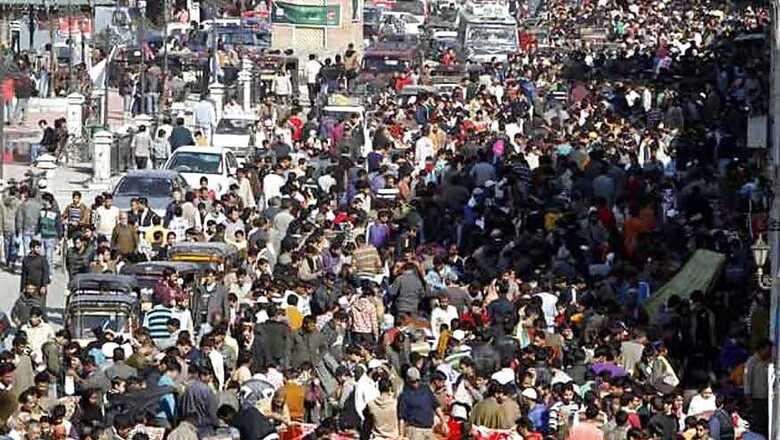
views
Addressing the nation from the ramparts of the Red Fort on the occasion of 73rd Independence Day, Prime Minister Narendra Modi raised serious concerns for uncontrolled population growth.
“If the population is not educated, not healthy, then neither the home nor the country can be happy,” he said. Linking it to patriotism, he further asked the countrymen to learn from responsible citizens who have kept their families small, thereby stemming the population growth which has acquired a worrisome proportion.
Similar concerns were earlier raised in the recently concluded session of Parliament by Member of Parliament Prof. Rakesh Sinha when he introduced a private member bill, The Population Regulation Bill, 2019, in the Rajya Sabha. It has stirred a series of debates surrounding its intentions.
This private member bill is a welcome step, keeping in view the resolution passed by the Rashtriya Swayamsevak Sangh (RSS) at its Akhil Bharatiya Karyakari Mandal, in 2015 demanding the government to “reformulate the national population policy keeping in mind the projection of the country’s population for the next 50 years and the available resources to meet the need of that number”.
The concerns of the RSS on population growth and availability of resources is endorsed by recently released UN’s World Population Prospects 2019, according to which, India is poised to overtake China as the world’s most populous country by the year 2027.
The report further adds that, “India is expected to add nearly 273 million people between 2019 and 2050 and will continue to be the world’s most populous country till the end of current century with around 1.5 billion inhabitants followed by China with 1.1 billion people.”
The report, therefore, concluded that India’s population projection with disparate population growth rate will re-order its ranking by size in the world which is alarming and should be at the centrestage of any deliberations involving the government and civil society. These substantial changes in the size, composition and distribution of India’s population will have severe consequences on the sustainability of Indian economy and environment.
Populations are at the core of any discourse related to sustainable development, thus demographic megatrends of population-growth and urbanisation hold severe challenges for sustainability. The resultant impact of unchecked population growth, therefore, will trigger a downward slide in achieving the Sustainable Development Goals (SDGs), which are the universally agreed objectives for improving economic prosperity and social well-being while protecting the environment. Thus, a timely intervention on the part of Indian government will go a long way in not only anticipating future needs but also developing and planning of policies to fulfil varying needs of the masses in an efficient manner.
The myth surrounding the narratives of demographic dividends has been busted as the levels of unemployment and inequalities are on the rise mostly attributed to factors of globalisation coupled with ‘digital-disruption’ and mechanisation. This necessitates the need for a national action policy framework for the economic, social and environmental spheres to safeguard life and livelihood of the masses.
With the ever growing competition for liveable space, critical resources such as water, land, etc., and the prospects for economic development and livelihood has become the biggest challenge in 21st century. These resultant demographic changes have further exacerbated the inequities in the distribution of resources and opportunities across the various stakeholders in almost all the states of India today.
The fact that unchecked population growth and associated consumption patterns is gravely jeopardizing our efforts to fight global warming and climate change is even alarming. As several regions of India is facing the consequences of such uncontrolled and unsustainable use of the natures resources. The recent case being the severe water scarcity faced by the people of Chennai in Tamil Nadu.
India has around 18 per cent of world’s population and just 4 per cent of world’s water resources at its disposal, which makes the situation very alarming. The worst part is that 70 per cent of this water is contaminated and is being used unregulated.
The Composite Water Management Index report published by NITI Aayog states that by 2020, the groundwater table of 21 major cities of India is going to be exhausted affecting more than 100 million people is in itself raise concern regarding the carrying capacity of nature. This clearly shows how strained and deficient the service delivery will be if there are too many mouths to feed in a limited and scarce environment.
The data collected from a study conducted by the Agricultural Ministry suggests that with the present rates of population growth, India will have an additional 430 million mouths to feed by 2050, and to keep pace with the population, cereal production must grow by at least 4.2% a year, more than twice the current rate which is going to be a humongous task given the fact that India has only 2.4 per cent of the world land mass. Therefore, it should not amuse us why India ranks at 103rd position among 119 countries in the Global Hunger Index of 2018.
Population growth when unchecked breeds poverty. As per a new report by the United Nations Development Programme (UNDP) and the Oxford Poverty and Human Development Initiative report, India has been able to lift 271 million people out of multidimensional poverty during the period 2006-2016. But the serious concern is that India still has 373 million people who continue to experience acute deprivations.
India currently has the largest number of people living below the poverty line. Unchecked population growth has huge ramifications on the health of the national economy. India economy currently is ranked 6th largest in the world (International Monetary Fund, 2017-18) and is poised to be a $5 trillion economy in near future. But what worries this growth graph is the levels of per capita income which is among the lowest in the world. India ranks 139 among 187 countries in GDP per capita income (PCI) terms with just $1,983 PCI (International Monetary Fund, 2017-18).
Thus, proactive measures like ‘the Population Regulation bill 2019’ are the need of the hour. The proposed bill works on the principle of incentivisation rather than penalising. It suggests that people with more than two offsprings will be barred from contesting elections at all levels. Further, it lays down a list of incentives (increments, loans, free health and education to preferences to single child in all government jobs) which the government can give to its employees adhering to the two child policy. The proposed legislation on population could be a reality in near future when Prime Minister Modi called population explosion as the real challenge and threat to India’s prosperity and growth story.
(The author is Associate Professor, Delhi University. Views are personal)




















Comments
0 comment